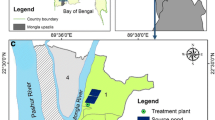Abstract
High number of refugees, internally displaced people (IDP) and nomadic camps were established in the aftermath of intensive military operations and militant activities from 2000 onwards in different regions, especially areas near Afghanistan border of Khyber Pakhton Khwa (KPK), Pakistan. In this study we analyzed the quality of well drinking water in three (A, B, C) different camps situated in Kohat Division in April 2011. Well water samples were serially diluted and inoculated in respective media by spread plate technique standard procedure, and incubated at 37±1 °C for 24–36 hours. The viable count of tested microorganism was mentioned in form of CFU. Daily uptake of microbial load/person/day was calculated and each source contribution was measured by using ANOVA. Results showed that total viable count, fungal count and their daily uptake were significant in all stations, while Fecal Coliform (E. coli), Salmonella, Shigella and S. cocci loads were enormous in station B followed by station C. In station A microbial load was comparatively lesser than in station B and C. Moreover, stations A, B, and C have higher enteric pathogenic microbial load than are WHO recommended standards for potable water.


Similar content being viewed by others
References
Ahmed SA, Hogue BA, Mahmud A (1998) Water management practices in rural and urban homes: a case study from Bangladesh on ingestion of polluted water. J Public Health 112:317–321
Anderson KA, Davidson MP (1997) Drinking water and recreational water quality: microbiological criteria. http://www.cals.uidahoedu/edcomm/pdf/CIS/CIS1069. Accessed on 20 November 2010
Ashbolt NJ, Storey MV (2003) A risk model for enteric virus accumulation and release from recycled water distribution pipe biofilms. Water Supply 3(3):93–100
Ashbolt NJ, Grabow WOK, Snozzi M (2001) Indicators of microbial water quality. In: Fewtrell L, Bartram J (eds) Water quality: guidelines, standards and health. Risk assessment and management for water-related infectious disease. IWA, London, pp 289–315
Assembly of Life Sciences (US) (1977) Drinking water and health. National Academy of Sciences. Accessed November 2011
Atlas RM (1999) Legionella: from environmental habitats to disease pathology, detection and control (Review). Environ Microbiol 1(4):283–293
Avery SM, Moore A, Hutchison ML (2004) Fate of Escherichia coli originating from livestock faeces deposit directly onto pasture. Lett Appl Microbiol 38:355–359
Chrostowski PC (1994) Exposure assessment principles. In: Patrick DR (ed) Toxic air pollution handbook. Van Nostrand Reinhold, New York, pp 133–163
Edberg SC, Rice EW, Karlin RJ, Allen MJ (2000) Escherichia coli: the best biological drinking water indicator for public health protection. J Appl Microbiol Symp Suppl 88(Suppl S):106S–116S
Enriquez C, Nwachuku N, Gerba CP (2001) Direct exposure to animal enteric pathogens. Rev Environ Health 16(2):117–131
Ginn TR, Wood BD, Nelson KE, Scheibe TD, Murphy EM, Clement TP (2002) Processes in microbial transport in the natural subsurface. Adv Water Resour 25:1017–1042
Hunter PR, Waite M, Ronchi E (2002) Drinking water and infectious disease: establishing the links. IWA, London
Kress M, Gifford GF (1984) Fecal coliform release from cattle fecal deposits. Water Resour Bull 20(1):61–66
Mosupye FM, von Holy A (1999) Microbiological quality and safety of ready-to-eat street-vended foods in Johannesburg, South Africa. J Food Protec 1278–1284
Mudgil S, Aggarwal D, Ganguli A (2004) Microbiological analysis of street vended fresh squeezed carrot and kinnow–mandarin juices in Patiala City, India. Int J Food Saf 3:1–3
Murray C Rod D, Andrew B, Ruth P, Marion S, Zella S (2008) Microbial groundwater quality and its health implications for a border-strip irrigated dairy farm catchment, South Island, New Zealand. J Water Health 6(1):83–98
Paneth N, Viten-Johansen P, Brody H, Al E (1998) A rivalry of foulness: official and unofficial investigations of the London cholera epidemic of 1854. Am J Publ Health 88(10):1545–1553
Sinton L, Hall C, Braithwaite R (2007) Sunlight inactivation of Campylobacter jejuni and Salmonella enterica, compared with Escherichia coli, in seawater and river water. J Water Health 5(3):357–365
Thelin R, Gifford GF (1983) Fecal coliform release patterns from fecal material of cattle. J Environ Qual 12(1):57–63
Unc A, Goss MJ (2004) Transport of bacteria from manure and protection of water resources. Appl Soil Ecol 25:1–18
United Nations Educational, Scientific and Cultural Organization (2003) Water for people for life: the United Nations world water development report
US EPA (1992) Guidelines for exposure assessment, EPA/600/Z-92/001. Risk Assessment Forum, Washington, DC
WHO (2002) Water for health enshrined as a human right. http://www.who.int/mediacentre/news/releases/prl/en. Accessed on 15th November 2010
WHO (2004a) Water sanitation and hygiene links to health. Facts and figures. www.who.int/water_sanitation_health/publications/facts2004/en/print.html. Accessed on 15th November 2010
WHO (2004b) Guidelines for drinking-water quality, vol 1: recommendations, 3rd edn. World Health Organization, Geneva
Author information
Authors and Affiliations
Corresponding author
Rights and permissions
About this article
Cite this article
Muhammad, N., Bangush, M. & Khan, T.A. Microbial Contamination in Well Water of Temporary Arranged Camps: A Health Risk in Northern Pakistan. Water Qual Expo Health 4, 209–215 (2012). https://doi.org/10.1007/s12403-012-0080-0
Received:
Revised:
Accepted:
Published:
Issue Date:
DOI: https://doi.org/10.1007/s12403-012-0080-0




